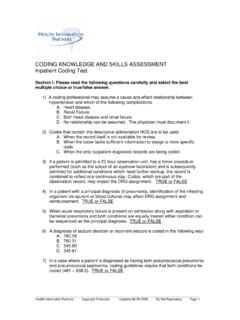Transcription of ICD-9-CM Official Guidelines for Coding and Reporting
1 ICD-9-CM Official Guidelines for Coding and Reporting Effective October 1, 2011 Narrative changes appear in bold text Items underlined have been moved within the Guidelines since October 1, 2010 The Centers for Medicare and Medicaid Services (CMS) and the National Center for Health Statistics (NCHS), two departments within the Federal Government s Department of Health and Human Services (DHHS) provide the following Guidelines for Coding and Reporting using the International Classification of Diseases, 9th Revision, Clinical Modification (ICD-9- CM).
2 These Guidelines should be used as a companion document to the Official version of the ICD-9-CM as published on CD-ROM by the Government Printing Office (GPO). These Guidelines have been approved by the four organizations that make up the Cooperating Parties for the ICD-9-CM : the American Hospital Association (AHA), the American Health Information Management Association (AHIMA), CMS, and NCHS. These Guidelines are included on the Official government version of the ICD-9- CM, and also appear in Coding Clinic for ICD-9- CM published by the AHA.
3 These Guidelines are a set of rules that have been developed to accompany and complement the Official conventions and instructions provided within the ICD-9-CM itself. The instructions and conventions of the classification take precedence over Guidelines . These Guidelines are based on the Coding and sequencing instructions in Volumes I, II and III of ICD-9- CM, but provide additional instruction. Adherence to these Guidelines when assigning ICD-9- CM diagnosis and procedure codes is required under the Health Insurance Portability and Accountability Act (HIPAA).
4 The diagnosis codes (Volumes 1-2) have been adopted under HIPAA for all healthcare settings. Volume 3 procedure codes have been adopted for inpatient procedures reported by hospitals. A joint effort between the healthcare provider and the coder is essential to achieve complete and accurate documentation, code assignment, and Reporting of diagnoses and procedures. These Guidelines have been developed to assist both the healthcare provider and the coder in identifying those diagnoses and procedures that are to be reported.
5 The importance of consistent, complete documentation in the medical record cannot be overemphasized. Without such documentation accurate Coding cannot be achieved. The entire record should be reviewed to determine the specific reason for the encounter and the conditions treated. The term encounter is used for all settings, including hospital admissions. In the context of these Guidelines , the term provider is used throughout the Guidelines to mean physician or any qualified health care practitioner who is legally accountable for establishing the patient s diagnosis.
6 Only this set of Guidelines , approved by the Cooperating Parties, is Official . The Guidelines are organized into sections. Section I includes the structure and conventions of the classification and general Guidelines that apply to the entire classification, and chapter-specific Guidelines that correspond to the chapters as they are arranged in the classification. Section II includes Guidelines for selection of principal diagnosis for non-outpatient settings. Section III includes Guidelines for Reporting additional diagnoses in non-outpatient settings.
7 Section IV is for outpatient Coding and Reporting . ICD-9-CM Official Guidelines for Coding and Reporting Effective October 1, 2011 Page 2 of 107 Section I. Conventions, general Coding Guidelines and chapter specific Guidelines .. 6 A. Conventions for the ICD-9- CM .. 6 1. Format: .. 6 2. Abbreviations .. 6 a. Index abbreviations .. 6 b. Tabular 6 3. Punctuation .. 6 4. Includes and Excludes Notes and Inclusion terms .. 7 5. Other and Unspecified codes .. 7 a. Other codes .. 7 b. Unspecified 7 6. Etiology/manifestation convention ( code first , use additional code and in diseases classified elsewhere notes).
8 8 7. And .. 8 8. With .. 9 9. See and See Also .. 9 B. General Coding Guidelines .. 9 1. Use of Both Alphabetic Index and Tabular List .. 9 2. Locate each term in the Alphabetic Index .. 9 3. Level of Detail in Coding .. 9 4. Code or codes from through 10 5. Selection of codes through .. 10 6. Signs and symptoms .. 10 7. Conditions that are an integral part of a disease process .. 10 8. Conditions that are not an integral part of a disease process .. 10 9. Multiple Coding for a single condition .. 10 10. Acute and Chronic Conditions .. 11 11.
9 Combination Code .. 11 12. Late Effects .. 11 13. Impending or Threatened Condition .. 12 14. Reporting Same Diagnosis Code More than Once .. 12 15. Admissions/Encounters for Rehabilitation .. 12 16. Documentation for BMI and Pressure Ulcer Stages .. 12 17. 13 18. Documentation of Complications of care .. 13 C. Chapter-Specific Coding Guidelines .. 13 1. Chapter 1: Infectious and Parasitic Diseases (001-139) .. 13 a. Human Immunodeficiency Virus (HIV) Infections .. 13 b. Septicemia, Systemic Inflammatory Response Syndrome (SIRS), Sepsis, Severe Sepsis, and Septic Shock.
10 16 c. Methicillin Resistant Staphylococcus aureus (MRSA) Conditions .. 21 2. Chapter 2: Neoplasms (140-239) .. 23 a. Treatment directed at the malignancy .. 23 b. Treatment of secondary site .. 23 c. Coding and sequencing of complications .. 24 d. Primary malignancy previously excised .. 24 e. Admissions/Encounters involving chemotherapy, immunotherapy and radiation therapy .. 25 ICD-9-CM Official Guidelines for Coding and Reporting Effective October 1, 2011 Page 3 of 107 f. Admission/encounter to determine extent of malignancy .. 26 g. Symptoms, signs, and ill-defined conditions listed in Chapter 16 associated with neoplasms.











